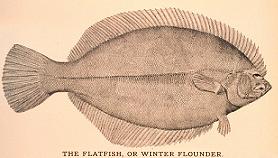As the sun sinks lower in the sky, slipping daily toward its nadir at the Winter Solstice, it is difficult for many residents of Queens to contemplate spending a day at the shore, much less entering the water. But they should rest assured that, in the bays which gird both shores of the borough, there are fish that have no such qualms.
Beginning in early fall, when the waters first begin to cool, winter flounder start moving out of the deeper, cooler waters of Long Island Sound and the nearshore ocean and slip into the bays. At one time, not very long ago, there were a myriad of them, seemingly paving the bottom and filling the buckets of a large and enthusiastic sportfishing community. Most of the fish caught weighed less than a pound, but what they lacked in size they made up in numbers. Jamaica Bay and Sheepshead Bay hosted a flounder fleet comprised of private boats, rental boats and larger for-hire party boats filled with anglers seeking to make a meal of what was arguably the region’s most popular salt-water panfish. The same scene was reflected in a smaller scale on the North Shore, in Little Neck Bay, and at just about every place where the public has access to the water.
Today, far fewer flounder return to the inshore shallows each fall. Biologists at the Atlantic States Marine Fisheries Commission, an interstate fisheries management body, have estimated that the population is less than ten percent of what it was just twenty years ago. The situation has gotten bad enough that, following an ASMFC recommendation, the New York State Department of Environmental Conservation only permits recreational flounder fishing for sixty days in the spring, after the fish have completed spawning and before they leave the bays for the summer.
Still, what remains of the local winter flounder population continues to follow the ancient imperative to perpetuate their kind. The cold winter water slows them down, and they spend quite a bit of time without moving, covered by a thin, concealing layer of sand or mud. Yet winter is a time for spawning. The fish do so throughout the season, with peak activity occurring in late February and March. Unfortunately, the number of young flounder produced has recently been too small to replace the older fish removed from the population. Unless something changes, we may live to see the time when flounder no longer return to the coastal bays that they’ve inhabited since the retreat of the last glacier.
Flounder are not the only winter species that has fallen on hard times. Silver hake — better known as “whiting” or, locally, “frostfish,” once provided fun and food for anglers along New York City’s southern shore. The fish, which spend most of their time in the deeper waters of the continental shelf, were particularly prone to come close to shore at night, where they chased sand eels and other small bait right up to the beach. Breezy Point, in the Rockaways, was one place that frequently saw whiting activity, and some conjecture that the name “frostfish” came from fact that they grew so reckless in their pursuit of prey that many would get washed onto the sand, and people walking the surfline could pick the fish up, fresh and stiffening in the evening cold, right from the beach, and fill a pail without having to trouble themselves with rod, line or bait.
Another popular whiting spot was the Coney Island Pier, where nighttime anglers, bundled in their heaviest clothes, lined the rails to catch whiting and their relative, the red hake or “ling.” However, the whiting population has left New York waters and, whether caused by overfishing or by some unknown factor, this has left a big hole in the web of life that fills the winter sea.
Tomcod, a diminutive member of the cod family that, particularly in Long Island Sound, shared the “frostfish” moniker with the whiting, also seems to have suffered a sharp decline in numbers. Accounts of netting or otherwise catching tomcod can be found in some of the earliest histories of Queens County, and anglers fishing from shore and small boats caught pailfuls of them, particularly in places such as Little Neck Bay and quiet coves off the East River, right through the coldest months of the year. Some are still seen, but today’s numbers are only a shadow of what existed just a few decades ago.
Still, there is also good news. Atlantic herring remain abundant, and the biologists who study them assure us that they are not being overfished. Although herring spend most of the year in cooler northern waters, where they provide important food for cod, pollock, haddock, tuna and other fish species, as well as for whales, seals and many seabirds, beginning in early November, they move into local waters. Flocks of gannets plummeting from the sky into the ocean often indicate a school of herring below. Similarly, the fall’s last big schools of migrating striped bass will feed on herring whenever they can find them, and even in December can sometimes be found in places such as Jamaica Bay, pushing up white water as they plow into densely packed herring shoals. When bass attack herring from below as gannets plunge into them from above, the resultant show can be one of the wildest sights of our winter sea.
Of course people, too, feed on herring, and an angler who gets cabin fever as the long nights of winter drag on can find relief anywhere along the shore where he can find deeper, moving water not locked up in ice. Places around the south shore are the most reliable — again, the Coney Island Pier is popular with winter anglers — but Long Island sound venues also pay off at times, although they tend to freeze over quickly when the air gets really cold. To cash in on the herring run, anglers don’t even need bait — a “herring tree” featuring three, four or five hooks covered in silver mylar and weighted down with a sinker or diamond jig can fill a pail in short order, and provide the first and most important ingredient in any pickled herring recipe.
And finally, there is the striped bass. Stripers are quiet in the winter. Most migrate south, to spend the winter somewhere between southern Virginia and North Carolina’s Cape Hatteras, but more than most people suspect spend the cold months in Long Island Sound. Biologists once thought that they were semi-dormant during that time, except for those fish that spent the winter near the warm-water outfalls of power plants. However, a study conducted by New York’s DEC a decade ago led to the surprising conclusion that the fish move about throughout the winter, traveling from Long Island to the Connecticut shore and everywhere in between.
Sometime, as you’re driving north on the Cross Island Expressway on a nice day in late February or early March, you might happen to glance over at Little Neck Bay and notice a handful of anglers fishing along the shore. They are striped bass fishermen, seeking winter-over fish when they first decide to feed. Although most striped bass caught during that time are small, by late March, anglers are hoping to tie into striped bass weighing ten pounds or more, and by early April, no one is surprised to hear that a twenty or thirty pound fish has been caught in Little Neck Bay. Although the winter is a resting time for striped bass, and there is no significant fishery for them during the coldest time of the year (and the law requires that any striped bass caught between December 15 and April 15 be released immediately), their presence is an important gauge of the future health of the species.
The adult fish that overwinter in the western Sound are thought to ascend the Hudson River to spawn later in the spring. It comes as a surprise to many people to learn that the Hudson River is the second-largest spawning ground for striped bass on the Atlantic Coast, producing about 25% of the coastal migratory population. Only Chesapeake Bay is more important to the striped bass, and not too many years ago—in the late 1970s and early 1980s—after the Chesapeake population collapsed, the Hudson River was, for a brief time, the primary producer.
At that time, the striped bass population had collapsed, and there were even some people who believed that a listing under the Endangered Species Act might be appropriate. However, instead of declaring the striped bass a loss, and accepting defeat, conservationists and anglers came together and demanded that fisheries managers do whatever was necessary to restore the population. The fishery was completely closed for a while, and when it reopened, it was placed under very tight regulation. However, it has since been declared fully restored, and supports the most important sport fishery, in terms of pounds landed, in the entire United States.
The sort of measures that were successfully used to restore the striped bass can also be applied to other species. All that is needed is the political will to impose the tough restrictions needed to cut back — and perhaps completely prohibit — harvest for a while, to give the fish a chance to reproduce and replenish themselves. Nature is resilient and, once the problems of overharvest and pollution are addressed, will quickly begin to repair itself. If we give it that chance, the winter ocean in winter will, in its way, be as vital and vibrant a place as the summer sea.
Charles Witek is the Chairman of Coastal Conservation Association's New York State chapter.




